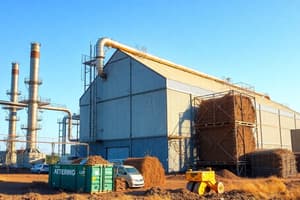Podcast
Questions and Answers
Its purpose is to recycle waste products by giving it to other people for free.
Its purpose is to recycle waste products by giving it to other people for free.
- Freecycling (correct)
- Upcyclin
- Open handed reuse
- Deconstruction
It is a material that is not biodegradable, but it can be recycled repeatedly without diminishing its quality.
It is a material that is not biodegradable, but it can be recycled repeatedly without diminishing its quality.
- Porcelain
- Clay
- Glass (correct)
- Metal
Which represents a process in the total materials cycle?
Which represents a process in the total materials cycle?
- Earth → Raw Materials → Synthesis and Processing → Manufacture, Assembly → Engineered Materials → Product Design → Application → Waste → Earth
- Earth → Recycle / Reuse → Synthesis and Processing → Engineered Materials → Product Design, Manufacture, Assembly → Application → Waste → Earth
- Earth → Raw Materials → Synthesis and Processing → Engineered Materials → Product Design, Manufacture, Assembly → Application → Waste → Earth (correct)
- Earth → Raw Materials → Synthesis and Processing → Engineered Materials → Product Design, Manufacture, Assembly → Application → Waste
The following are compositions of glass EXCEPT:
The following are compositions of glass EXCEPT:
Its purpose is to recycle used waste products.
Its purpose is to recycle used waste products.
Is technically a form of reusing, but it refers more specifically to items that are discarded and broken down into their raw materials.
Is technically a form of reusing, but it refers more specifically to items that are discarded and broken down into their raw materials.
The materials reused in recycling serve as substitutes for raw materials obtained from such increasingly scarce natural resources as the following EXCEPT:
The materials reused in recycling serve as substitutes for raw materials obtained from such increasingly scarce natural resources as the following EXCEPT:
Which is a type of reuse:
Which is a type of reuse:
What is the number on the recycle code of polypropylene?
What is the number on the recycle code of polypropylene?
Its main goals include preserving architectural and cultural heritage, transforming urban blight, and igniting social change.
Its main goals include preserving architectural and cultural heritage, transforming urban blight, and igniting social change.
It can help reduce the quantities of solid waste deposited in landfills, which have become increasingly expensive.
It can help reduce the quantities of solid waste deposited in landfills, which have become increasingly expensive.
Can be defined as using a waste product without further transformation and without changing its shape or original nature.
Can be defined as using a waste product without further transformation and without changing its shape or original nature.
Which of the following is NOT a part of the process in recycling metals:
Which of the following is NOT a part of the process in recycling metals:
This is the second option in the waste hierarchy.
This is the second option in the waste hierarchy.
It is a closed system, in that its materials resources are finite.
It is a closed system, in that its materials resources are finite.
Typical materials that are recycled include the following EXCEPT:
Typical materials that are recycled include the following EXCEPT:
Which of the following is an application on the total materials cycle.
Which of the following is an application on the total materials cycle.
Different types of solid wastes can be reused, such as the following EXCEPT:
Different types of solid wastes can be reused, such as the following EXCEPT:
It is the repurposing of buildings that have outlived their original purpose.
It is the repurposing of buildings that have outlived their original purpose.
Major sources of waste are from packaging, junked automobiles, automobile tires, and domestic durable goods.
Major sources of waste are from packaging, junked automobiles, automobile tires, and domestic durable goods.
This is a process from the total material cycle:
This is a process from the total material cycle:
The purpose of this is to recycle things that have been previously used by giving them away to other people for free.
The purpose of this is to recycle things that have been previously used by giving them away to other people for free.
What is the number on the recycle code of High-density polyethylene?
What is the number on the recycle code of High-density polyethylene?
What is the number on the recycle code of Polysterene?
What is the number on the recycle code of Polysterene?
Flashcards
Freecycling
Freecycling
Giving away used items for free to others, encouraging reuse and reducing waste.
Recyclable Materials
Recyclable Materials
Materials that can be recycled repeatedly without losing quality. Examples include glass and metal.
Total Materials Cycle
Total Materials Cycle
A complete cycle of materials, starting from natural resources, processing, manufacturing, use, waste, and back to either recycling or reuse.
Soda-Lime Glass
Soda-Lime Glass
Signup and view all the flashcards
Recycling
Recycling
Signup and view all the flashcards
Deconstruction
Deconstruction
Signup and view all the flashcards
Scarce Natural Resources
Scarce Natural Resources
Signup and view all the flashcards
Direct Reuse
Direct Reuse
Signup and view all the flashcards
Recycle Code: #5
Recycle Code: #5
Signup and view all the flashcards
Adaptive Reuse
Adaptive Reuse
Signup and view all the flashcards
Recycling and Landfills
Recycling and Landfills
Signup and view all the flashcards
Reuse
Reuse
Signup and view all the flashcards
Recycling Metals
Recycling Metals
Signup and view all the flashcards
Reuse in Waste Hierarchy
Reuse in Waste Hierarchy
Signup and view all the flashcards
Earth as a Closed System
Earth as a Closed System
Signup and view all the flashcards
Recyclable Materials Examples
Recyclable Materials Examples
Signup and view all the flashcards
Energy in Total Materials Cycle
Energy in Total Materials Cycle
Signup and view all the flashcards
Reused Waste Materials
Reused Waste Materials
Signup and view all the flashcards
Adaptive Reuse
Adaptive Reuse
Signup and view all the flashcards
Major Waste Sources
Major Waste Sources
Signup and view all the flashcards
Waste Recycle/Reuse
Waste Recycle/Reuse
Signup and view all the flashcards
Freecycling
Freecycling
Signup and view all the flashcards
Recycling and Landfills
Recycling and Landfills
Signup and view all the flashcards
Recycle Code: #2
Recycle Code: #2
Signup and view all the flashcards
Recycle Code: #6
Recycle Code: #6
Signup and view all the flashcards
Downcycling
Downcycling
Signup and view all the flashcards
Upcycling
Upcycling
Signup and view all the flashcards
Adaptive Reuse
Adaptive Reuse
Signup and view all the flashcards
Downcycling
Downcycling
Signup and view all the flashcards
Reduce Waste
Reduce Waste
Signup and view all the flashcards
Direct Reuse
Direct Reuse
Signup and view all the flashcards
Adaptive Reuse
Adaptive Reuse
Signup and view all the flashcards
Study Notes
Material Selection and Recycling
- Freecycling: Recycling waste by giving it to others for free
- Deconstruction: A process of taking apart waste materials to recover raw materials
- Open-handed reuse: Recycling waste by giving it to others without needing to modify it or create a new product.
- Upcycling: Recycling goods to manufacture products of greater value.
Materials Properties
- Glass: A non-biodegradable material that can be recycled repeatedly without losing quality.
- Porcelain, Clay, and Metal are NOT necessarily non-biodegradable AND recyclable materials.
Materials Cycle Process
- The materials cycle involves Earth, Raw Materials, Synthesis, Processing, Manufacturing, Assembly, Engineered Materials, Product Design, Application, and Waste. The cycle repeats.
- Option c. represents the cycle properly.
Glass Composition
- Glass is primarily made of soda-lime, leaded, and borosilicate
- Alkaline is NOT a part of the composition of glass.
Recycling Purpose
- Recycling's purpose is to reuse waste products
- This is achieved through different methods including 'creative reuse'.
Recycling Techniques
- Recycling: A process that involves taking apart discarded items and separating them to recover raw materials.
- Freecycling: A method of recycling used to donate items to people who want them for free.
- Deconstruction: A recycling method used to break apart items and recover their raw materials.
Recycling Materials Substitutes
- Recycled materials can replace raw materials that are becoming scarce.
- Examples that are NOT substitutes include Geothermal heat, a form of energy.
Reuse Types
- Reuse: Re-using an item without modifying its shape or original nature.
- Downcycling: Recycling that results in a lower quality product or material.
- Recycling: Process of recovering raw materials from waste items to create something new.
Recycle Codes
- Polypropylene: 5
- High-density polyethylene: 2
- Polystyrene: 6
Adaptive Reuse
- Adaptive reuse: Process of repurposing buildings that have outlived their initial use.
Waste Sources
- Common sources of waste include packaging, junked automobiles, tires, and durable goods.
- Plastics, rubber, and styrofoam are common types of waste materials commonly coming from these sources.
Recycling Methods - Waste Hierarchy
- Reuse is the second best option in the waste hierarchy after recovery.
Materials Recycled
- Materials commonly recycled include iron and steel scrap, aluminum cans, and glass.
- Appellation (or naming) is not a typical material recycled.
Waste Applications
- Energy is an example of an application in the materials cycle.
Re-usable Materials
- Materials such as bottles and old clothes can often be reused.
- Detergents are not typically re-usable in this sense.
Studying That Suits You
Use AI to generate personalized quizzes and flashcards to suit your learning preferences.




